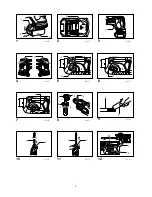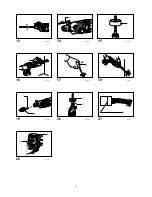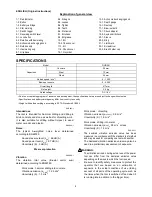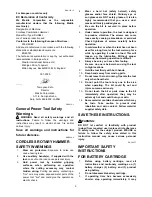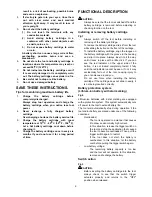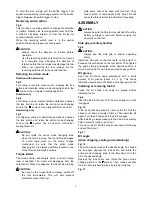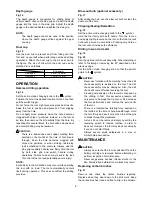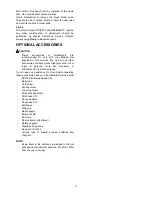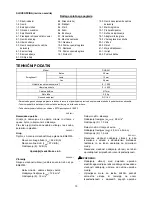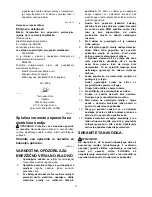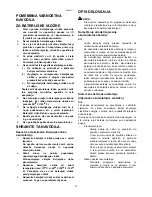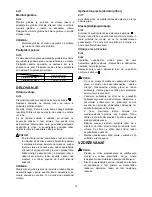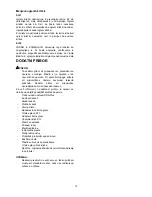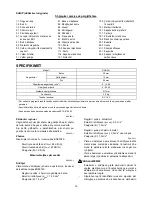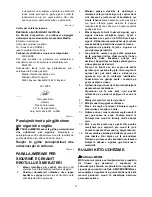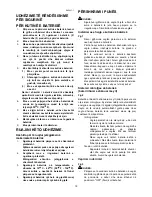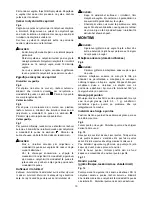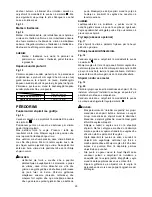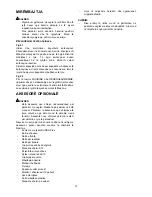
7
To start the tool, simply pull the switch trigger. Tool
speed is increased by increasing pressure on the switch
trigger. Release the switch trigger to stop.
Reversing switch action
Fig.4
This tool has a reversing switch to change the direction
of rotation. Depress the reversing switch lever from the
A side for clockwise rotation or from the B side for
counterclockwise rotation.
When the reversing switch lever is in the neutral
position, the switch trigger cannot be pulled.
CAUTION:
•
Always check the direction of rotation before
operation.
•
Use the reversing switch only after the tool comes
to a complete stop. Changing the direction of
rotation before the tool stops may damage the tool.
•
When not operating the tool, always set the
reversing switch lever to the neutral position.
Selecting the action mode
Rotation with hammering
Fig.5
For drilling in concrete, masonry, etc., depress the lock
button and rotate the action mode changing knob to the
symbol. Use a tungsten-carbide tipped bit.
Rotation only
Fig.6
For drilling in wood, metal or plastic materials, depress
the lock button and rotate the action mode changing
knob to the
symbol. Use a twist drill bit or wood bit.
Hammering only
Fig.7
For chipping, scaling or demolition operations, depress
the lock button and rotate the action mode changing
knob to the
symbol. Use a bull point, cold chisel,
scaling chisel, etc.
CAUTION:
•
Do not rotate the action mode changing knob
when the tool is running. The tool will be damaged.
•
To avoid rapid wear on the mode change
mechanism, be sure that the action mode
changing knob is always positively located in one
of the three action mode positions.
Torque limiter
The torque limiter will actuate when a certain torque
level is reached. The motor will disengage from the
output shaft. When this happens, the bit will stop turning.
CAUTION:
•
As soon as the torque limiter actuates, switch off
the tool immediately. This will help prevent
premature wear of the tool.
•
Hole saws cannot be used with this tool. They
tend to pinch or catch easily in the hole. This will
cause the torque limiter to actuate too frequently.
ASSEMBLY
CAUTION:
•
Always be sure that the tool is switched off and the
battery cartridge is removed before carrying out
any work on the tool.
Side grip (auxiliary handle)
Fig.8
CAUTION:
•
Always use the side grip to ensure operating
safety.
Install the side grip so that the teeth on the grip fit in
between the protrusions on the tool barrel. Then tighten
the grip by turning clockwise at the desired position. It
may be swung 360° so as to be secured at any position.
Bit grease
Coat the bit shank head beforehand with a small
amount of bit grease (about 0.5 -1 g). This chuck
lubrication assures smooth action and longer service life.
Installing or removing the bit
Clean the bit shank and apply bit grease before
installing the bit.
Fig.9
Insert the bit into the tool. Turn the bit and push it in until
it engages.
Fig.10
If the bit cannot be pushed in, remove the bit. Pull the
chuck cover down a couple of times. Then insert the bit
again. Turn the bit and push it in until it engages.
After installing, always make sure that the bit is securely
held in place by trying to pull it out.
To remove the bit, pull the chuck cover down all the way
and pull the bit out.
Fig.11
Bit angle
(when chipping, scaling or demolishing)
Fig.12
The bit can be secured at the desired angle. To change
the bit angle, depress the lock button and rotate the
action mode changing knob to the
O
symbol. Turn the
bit to the desired angle.
Depress the lock button and rotate the action mode
changing knob to the
symbol. Then make sure that
the bit is securely held in place by turning it slightly.
Fig.13


